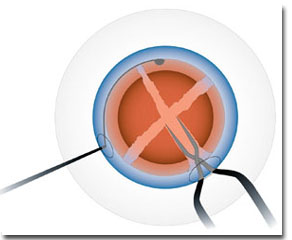| Trattamento microchirurgico della cataratta |
|
|
After 90° rotation, the lens cracking maneuver is repeated (Figure
4).  Now phacoemulsification is performed directly in Phase II, with aspiration of the four quadrants generated by cracking. The suggested parameters are: 15° phaco tip, 50% power, 200 mmHg vacuum, flow rate of 24 cc/min. the cracking. We have obeserved a cComplete cracking was observed in 60% of cases, while in the remaining 40% deeper forceps insertion and opening wasere necessary in the remaining 40% to achieve complete cracking. The learning curve for this technique is fast and if the cracking is not obtained, the case can be easily converted in the usual divide-and-conquer technique. We recommend, during the learning period, to operate, if cracking is not obtained, converting to the usual divide-and-conquer technique is extremely easy. During the learning period, we recommend operating 1+ and 2+ hard nuclei, showing a nice red reflex and with good pupil dilation. BIC is a safe and predictable technique, easy to standardize and learn. We think it is ideal for 1+ to 3+ hard nuclei, when the surgeon achieves a complete capsulorhexis and an effective hydrodissection. We do not recommend this technique for very soft or very hard nuclei, when the zonula is weak or the lens subluxated. When we Comparing it to divide-and-conquer, we observed that BIC offered us acompared BIC to the divide-and-conquer technique, we observed that the first offered 30% reduction in ultrasound time and a 8% rea8% reduction of the total surgical time. A safe control of ocular motion is possible with the BIC technique, and therefores the BIC technique provides optimal control of the ocular motion, it can be safely used with topical anesthesia, as well as by surgeons using the monomanual technique. The nucleus can be easily broken in four parts and it is not necessaryto four parts, without having to pursue the central bowl. Beside reducing the ultrasound time, with aconsequent longer life of the phaco tips, the BIC allowsmakes it possible to reduce the stress imparted to the zonula, as well as the nucleus tilt. Finally, it can be noted that with the BIC enables the surgeon canto use phaco tips with a lower angle and, therefore, better aspiration. |